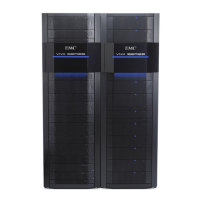Disk-array enclosures
EMC VNX8000 Hardware Information Guide 75
For more information about the drive carrier in a 3U, 120 or 4U, 60 DAE, see the “3U, 120
(2.5-inch) DAE (DAE8S)” section on page 94 and the “4U, 60 (2.5- or 3.5-inch) DAE
(DAE7S)” section on page 111.
Disk drives
Each disk drive consists of one disk drive in a carrier. You can visually distinguish
between disk drive types by their different latch and handle mechanisms and by type,
capacity, and speed labels on each disk drive. You can add or remove a disk drive while
the DAE is powered up, but you should exercise special care when removing disk drives
while they are in use. Disk drives are extremely sensitive electronic components.
Midplane
In a 2U, 25 or 3U, 15 DAE, a midplane separates the front-facing disk drives from the
rear-facing LCCs and power supply/cooling modules. It distributes power and signals to
all components in the enclosure. LCCs, power supply/cooling modules, and disk drives
plug directly into the midplane.
LCCs
In a 2U, 25 or 3U, 15 DAE, an LCC supports, controls, and monitors the DAE, and is the
primary interconnect management element. Each LCC includes connectors for input and
expansion to downstream devices. An enclosure address (EA) indicator is located on each
LCC (Figure 65 on page 83 and Figure 73 on page 92)
12
. Each LCC includes a bus (loop)
identification indicator (Figure 65 on page 83 and Figure 73 on page 92).
In a 3U, 120 DAE, an LCC supports, controls, and monitors the DAE, and is the primary
interconnect management element. Each LCC includes connectors for input and
expansion to downstream devices. An enclosure address (EA) indicator is located on each
LCC (Figure 101 on page 119)
11
. Each LCC also includes a bus (loop) identification
indicator (Figure 101 on page 119).
In a 4U, 60 DAE, the primary functionality of an LCC is to be a SAS expander as well as to
provide enclosure services to all the disk drives (60 in all). In other words, the LCC in a 4U
DAE (Figure 111 on page 129) implements a version of the Common Disk Enclosure
Sub-system (CDES) architecture. CDES consists of the PMC-Sierra PM8005 SXP 6G SAS
expander, the Common Disk Enclosure FPGA (CDEF) and supporting logic.
In the 4U, 60 DAE LCC, two SAS expanders are available. As previously described, the SAS
expanders are PMC-Sierra SXP36 6G (PM8005, rev C) components. Each expander
functions or operates separately. That is, each expander has its own CDEF and supporting
logic to support 30 drives each. A 4-lane SAS wide port connecting each expander to the
Inter Connect Module (ICM) expander on the same side (A or B) of the 4U DAE is available.
Each expander manages the drives it is connected to. The only shared resources are the
LCC LED and the expander I
2
C (inter-integrated circuit) bus.
12. The EA is sometimes referred to as an enclosure ID.

